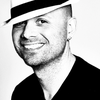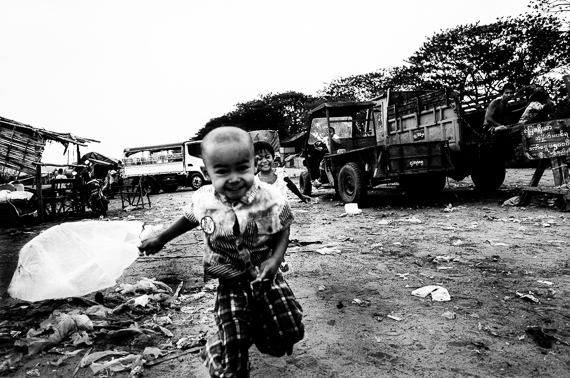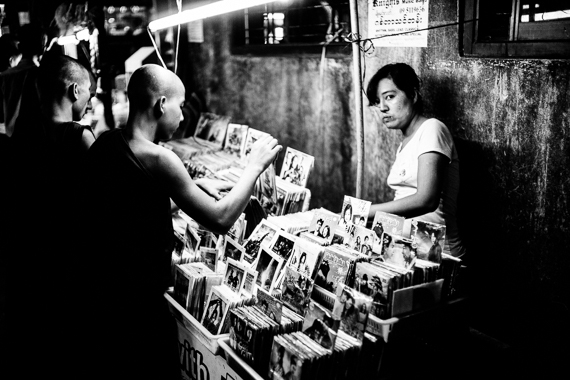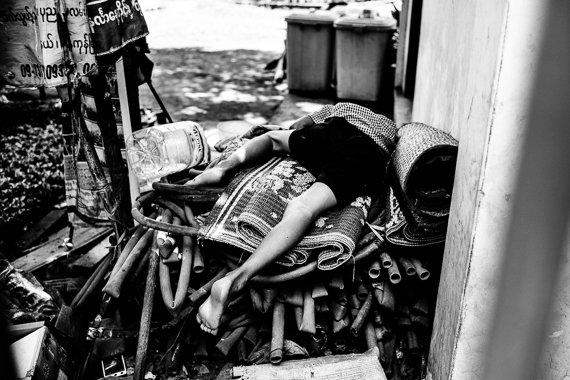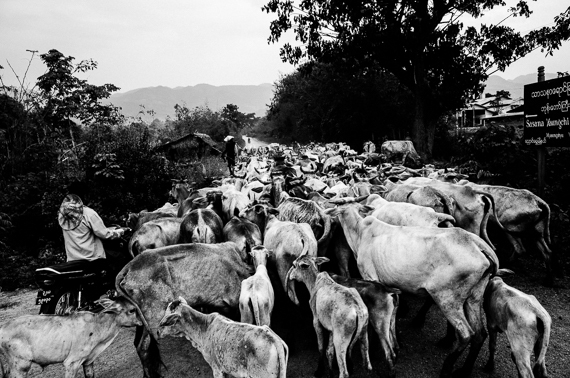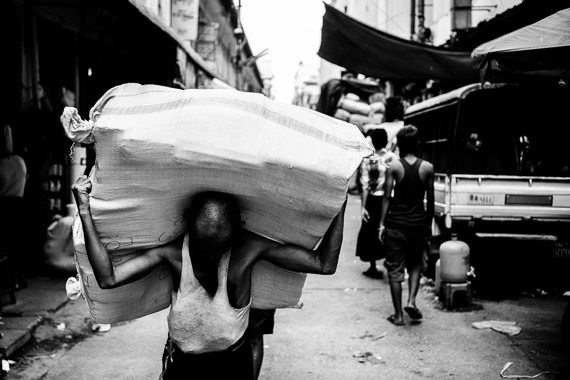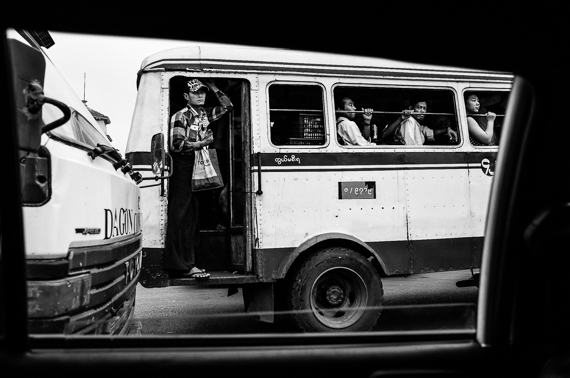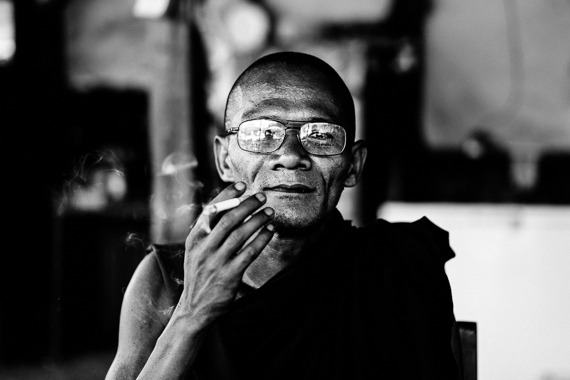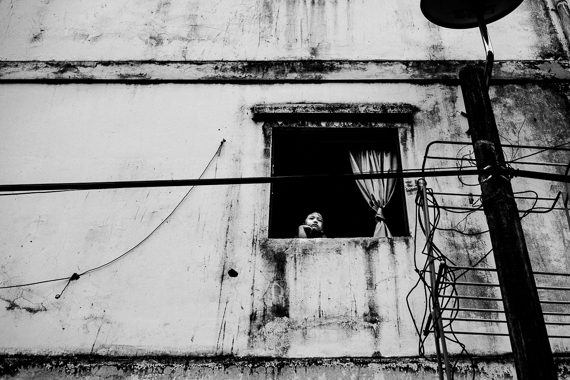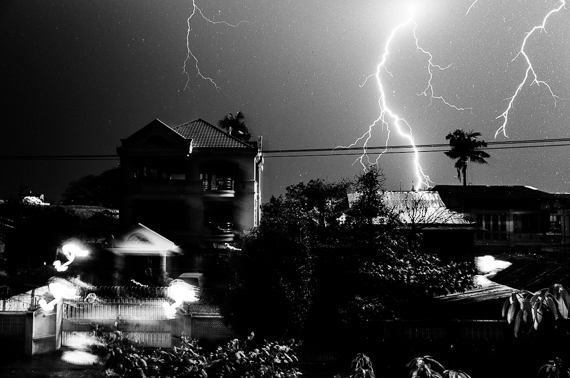Travel photography can be difficult. It's hard to take photos in a foreign land and not have them look like every other tourist photo of that time and place. This is harder, yet again, when one uses a compact camera - a snapshot machine - like the Ricoh GR. Yet, Chris Leskovsek, a 32-year-old Chilean-born photographer and designer, currently living and working in Auckland, New Zealand, has accomplished this exquisitely. These photographs are most certainly travel photos, taken by a foreigner in a foreign land, but they are also not merely travel photographs. That is, they are not simple amateur snapshots. Yet, this is not quite a documentary project either. "The Golden Land" is a series of photographs which seem to bridge the gap between travel snapshots and documentary photography, and they do it very well.
Michael Ernest Sweet: Chris, in some ways, this project reminds me of Daido Moriyama's journey to Tono. The dark contrasty images of the 'unfamiliar' but somehow loved; that is, although the imagery is dark, your love and compassion for the subject matter translates well. Was Burma completely random, or was there something there that was indeed calling you?
Chris Leskovsek: Well, thanks for such a comparison, as I deeply admire Moriyama's work and approach to photography. Like you said, the photos might look dark, but I do have strong feelings for the moments I was seeing there. Burma was random, in a sense, I went without any expectations; no plans. I really wanted to go and get lost, and literally let everyday encounters guide me through. Why Burma? It's really uncertain, but I've always been interested in places I know very little about, or that there is little information about.
MES: How long where you there for this project?
CL: Almost four weeks.
MES: Although I have never been to Burma, I sense that it is easy to photograph there. Am I right? How do the people react when they see you (an outsider) with your camera?
CL: I think it's always "easy" to shoot in any place you have never been before. Everything is new, and everything interests you. Most people in Burma, especially in the cities, are very curious of any outsider (Westerner) that might go into the city. Even more when that outsider wants to walk the narrow alleyways trying to get into the "real" everyday Burmese lifestyle. With that said, it was almost impossible to play "invisible" (not that I was trying) as they were more aware of me than I was of them.
People would often approach me, almost everyday, and ask to take my photo. So, suddenly I became the subject. Still, Burmese people have to work so hard and the cities are so packed that they don't mind a camera in the crowd. What is very hard is to know their culture and gestures, and not be disrespectful with them at any given moment - to be careful to photograph the right things.
MES: When I look for someone to interview, I look at various elements within the person's work. The selection process is usually surrounded by an affinity for the photographs - that is, if I like the work, I want to interview the person. Sometimes, however, I am motivated by a question the work poses. I interview because I want to know the answer to something. With you it was both. I do love this work, from a visual perspective, but really I wanted to interview you to discuss the "exotic" element within travel photography. Your photographs from this series are good compositions, your knowledge of the visual is obvious. However, I cannot help but think that your knowledge of the use of the "exotic" to draw in the viewer is also acutely developed. So, firstly, were you aware of the exotic element when you were photographing? Did you seek it out?
CL: Thanks for your kind words, Michael, but, the "exotic" element that you mention is something I didn't necessarily think of. To be honest, when you go to these kind of places, I believe the "exotic" is inherited for us westerners, I know it is for me.
I would lie to you if I said I was aware of everything I was doing while walking through streets, markets, landscapes, roads, etc in 42 degrees Celsius weather with 90% humidity. When I shoot, I focus on what is in front of me. But when I edit, I concentrate on what I want to say or tell, and most of the time it ends up being different from what I thought it would be. I think I can say that shooting for me is an intuitive process, but editing is a very conscious one.
MES: How do you feel about this concept in a more general way? For example, I'm not a great fan of HDR photography - at least the highly processed HDR stuff. I feel the image would fall flat most times if it were not for the gimmick of the HDR. In this way, do you feel that photographing a man carrying a large sack over his head is somehow taking advantage of the Western viewer's unfamiliarity with this scene (given that we don't see it on our own streets)?
CL: Well, absolutely, I'm a westerner and I went to Burma to see and experience what I haven't seen or experienced before. So yes, when I saw the old man walking with the big sack, I shot it, because it is something that I haven't seen before. For us Westerners it is very hard to imagine an old man (say in his 70s or 80s, maybe more) so active, carrying a sack that might even weigh more than he does; never mind the crowded road or his flip-flops. That to me says a lot about how they live their life. Is it healthier? Maybe. Economically poorer? I don't really know. I was looking for these kind of questions, but not necessarily the answers. I wanted to learn and witness this reality so different to mine. Perhaps I meant it as a critique to us, Western society, more so than taking advantage of an old man.
MES: Suppose I were to take a photograph of a woman carrying plastic shopping bags here in New York and published the image in the poorest under-developed city I could find. I suspect the image would have a lot more visual draw to that foreign audience. Where here, in the West, the woman with the shopping bag is almost always a boring and amateur street photo. I'm sorry for the lack of a precise question here, but can you speak to this a little?
CL: I see where you are going with the question, Michael. Is interesting how you feel that the same subject in a different context can change it's perception so much. Perhaps it is indeed like that and perhaps I shot it because of that. Because an old lady in Western societies wouldn't carry a sack that big other than a shopping bag. Whereas in Burma, the old man might possibly be carrying his life on his shoulders. Also, the two young men walking in opposite directions to the old man carrying that huge sack was normal to them, whereas in our society, we would run to help the older person to carry their bags. Perceptions. Questions. I really don't know the answers.
MES: By the way, I love your work, Chris. I am in no way suggesting that it is merely sensational. I just wanted to pick your brain a bit on this concept. Woody Allen, in Midnight in Paris, suggests that a viewers unfamiliarity with something, combined with their imagination, can produce a powerful but false affection. I wonder how my ignorance of Burma, combined with my imagination for the exotic, impacts my viewing of this work. It's an interesting concept. Then again, we all bring ourselves to anything visual, that is, vision is subjective at all times on some level. Do you think I am being too philosophical here, or is there something to my rambling?
CL: When I was researching about Burma, the only thing I would find is sunsets and landscapes, and if I really looked deeper, I found some documentary photographers that have shot the political problems, and even the drug and animal trafficking near the borders. But what about the regular people, the ones that keep a country and culture going, but don't make it on the news or don't attract the tourist and his lens? There was something there I wanted to see and explore.
MES: Shifting gears a little, I'd like to ask about a few of these photographs more specifically. For example, the one with the man standing in the bus doorway. This is a great image. It possesses many iconic elements - the three people in the windows gripping the frame (one looking directly into your lens), the window of your vehicle providing a natural frame for the photograph and, finally, the slightly overall snapshot feeling of the image. It all combines well both visually and graphically. How do you feel about this image? I feel it is one of the best from this series, are you surprised by that comment?
CL: One of the things that really caught my attention soon after walking the streets of Yangon, was that public buses were exactly the same as the ones we had in Chile in the 80s and early 90s, but also how crowded they were. People would be hanging out the doors, and most of the time, the buses wouldn't have windows - just frames with handles. Their perception of security is absolutely different than ours. I was very attracted to them. Perhaps I picked this one because it gave me a peaceful feeling within such a chaotic environment.
Now, is this photo is one of the best, I really don't know. I know I like it, and that's why I published it, but yes, you are the first one talking to me about this one.
As for the snapshot feel to it, I think it's great. Some photographers feel almost "insulted" when you say that word next to their work. I don't, in fact the concept really appeals to me. The 'snapshot' has something that other types of photos (I don't even know what they are called, the 'other' type of photos) don't. To me it feels closer to the viewer, it feels spontaneous, it is real, it is raw. It might be loose sometimes, but it's honest. I like imperfections in photography.
MES: I agree completely. I'm a snapshot photographer. My current project is being completed entirely with disposable cameras and I love the feeling of the work I'm getting. I also love that feeling in your work generally, and in this image specifically. Another favorite is the Monk smoking the cigarette. What a powerful photograph. In one simple image you have blown away the Western stereotype of the Buddhist monk. And it's not only the cigarette, it's also the look in his eyes - the slightest, almost imperceptible grin. With this one image you've made the Buddhist monk - almost a caricature to many Western people - into a real person, a man with a cigarette. In a sense you unmasked the mysticism. Can you tell us a little about this photograph, this man?
CL: In Burma it is very common to see monks walking down the streets. Then I realized that younger monks were playing with smartphones and even some older ones had fancy cameras. 'How could this be possible?' I wondered. After a couple of weeks I met an ex-English teacher, retired Buddhist Monk and current Buddhist teacher. He approached me just to talk. After a few hours of talking, I asked about the young monks with cellphones and photo cameras, he looked at me and said, "Every man needs to do monastery life throughout their life. Usually when they are teenagers. Monastery life involves a lot of meditation and learning about life, most families send their children to monasteries for schooling, as they cannot afford other methods. But, some younger monks feel pressured to be part of this life and they only do it because their families tell them to."
On the other hand, Burma is facing "Westernization" and it has moved into the country rather quickly in the past few years. One of the first things you see in terms of this is the cell phones. Even though internet service is almost non-existent (by any western standard) and controlled by the government, cell phones give them a social status. When I asked the teacher where they get the money, he said, he said: "That's the problem, Monks don't get paid for being monks, but people donate their hard earned money to the monasteries." -He said- "for reasons such as this, is that older monks, like myself, don't really consider this younger generation of monks to be authentic or 'real' monks'". Intrigued by this, I wanted an image that could show this somehow.
So, after seeing young monks drinking Red Bull, talking on cellphones, and using ray bans (pretty normal western stuff), I took a taxi back to the hotel and asked the driver if he could take me to a local restaurant and not a tourist spot. He agreed and drove me to this very precarious open air kitchen with a tent on a dusty rural road. While eating, this monk comes in and was asking for donations (money or food). He went to the cashier lady and asked for cigarettes. He lights the first one and approaches my table, pulls out a notepad from under his arm and flips to a page that had a little English note asking for donations. I replied saying I would give him a donation if he would allow me to take his picture. He agreed. (all of this with sign language, we didn't exchange any words). I grabbed my camera and took one or two shots. Then he puffs the cigarette and I click again, he pulls the cigarette out of his mouth again and I say that it doesn't matter if he smokes, so he inhales, exhales, and pulls the cigarette out, click!. That was it; it was a warm and friendly exchange.
Then, I realized that he also had the 'brand new' plastic sticker on his glasses as well. They leave it on, again as a status symbol.
I chose this shot instead because the image of a cigarette is very different than a cellphone, yet the cigarette somehow helps remove that layer of, as you say, "mysticism", that us Westerners project onto monks. They are humans, with as mundane of desires as everyone else. Sadly, this little detail has brought a lot of conflict within their society.
MES: Tell us about this image of the little boy in the window. I also like this one very much. Again, it invokes the Moriyama feeling - the dark contrast, the wires, the almost menacing feeling of the strangled curtain. It's a great photograph, what's the story?
CL: A few blocks from my hotel, they would do a "night market", which means that they close some very narrow streets for street vendors to sell their vegetables and raw meat. I was walking through this very narrow street (wouldn't fit no more than a car in one direction) surrounded by very tall crowded buildings. As I walked through these tiny narrow streets with crowds of people passing me, I stopped and looked up. I saw the empty window. I pulled the camera up, when I did, a kid shows up, then a second one, most likely his brother. The first one leaves, but I keep shooting. He eventually adopts this meditative pose, as he was contemplating this noisy river of people down below. I click, he then sees me, smiles, and leaves. I move on. I have learnt that every now and then, it is always good to look back, there's a different world behind you - always.
MES: Chris, what equipment were you using for this project? Some images feel like they could have been shot with a good compact (MJU II) and others feel like a Leica with a wide lens 21mm etc. I also sense digital when I look at some images and film with others. I really cannot imagine what you were using.
CL: Well, I used a simple Ricoh GR, and a Sony A7 with a Leica 35mm 'lux and a zeiss 55mm.
MES: I love the Ricoh series. My book, The Human Fragment (Brooklyn Arts Press), was shot entirely with the Ricoh GR Digital IV - totally awesome camera. When did you first pick up a camera? How did you become a "photographer"?
CL: My dad bought the first digital camera, I think back in 98 or 99. I was hooked. After that I started design and photography was always more of a companion to my design work. Then, before coming to New Zealand, I was already experimenting more seriously with film and shooting more and more. My "a-ha" moment came after I landed in NZ back in 2011. Everything was new, different, also some things went sour upon my first year, and I found myself picking up my camera as an escape to what I wanted to do and say. For the last two or three years, I've been shooting and wandering endlessly.
MES: I can totally relate. What's next?
CL: I've been focusing all my energies shooting and publishing my work. It's hard in a little country like NZ, so I started self-publishing a project called Øbservations, so far I have published five books. This series will finish with number six later in November of this year along with my first solo exhibition about it, here in Auckland.
The reason I'm finishing the series is because I'm self publishing (meaning I'm funding everything, and funds are always limited when you don't have support) and I need that money to move onto other projects. I really wish I could publish "The Golden Land". We will see what the future brings.
Also in December, I'll be heading down to South Island, here in New Zealand, to shoot another project which will be a photo book with music.
MES: Self-publishing is becoming very respected in the photography world. I think there are so many opportunities there now that were not available even a few years ago. In fact, I want to self-publish. I'm becoming frustrated with the traditional publishing process and the drawn out timetables for getting a book to market. I mean, having a Steidl book will always be "something else", but in terms of small press or self-publishing - it's really a toss-up.
CL: If you haven't self-publish anything yet, I'd say, do it, just go for it. Do one copy for you and go from there. Obviously you already have the experience of publishing a 'formal' book so you already know the process. In my case, the experience of self-publishing have been very rewarding, not because I've sold a few books, but because I've made lots of mistakes to learn from and I've met awesome people in the process. Besides, to me, there's nothing like the smell of printed paper while flicking through the pages (perhaps that is where my graphic and art background shows up). Printed is where I see photography come to life, and not just on paper, but on T-shirts, or screen-printed, etc.
MES: Chris, thank you kindly for your time and for sharing these wonderful travel photos. This work really is inspiring and I look forward to seeing more from you.
CL: Thank you Michael, once again, for the opportunity and for featuring my work. This means a lot to me and I really appreciate it. I'm looking forward in sharing future projects!
Want to have your photography featured here? Tweet me your best stuff @28mmphotos or contact me through my website.
